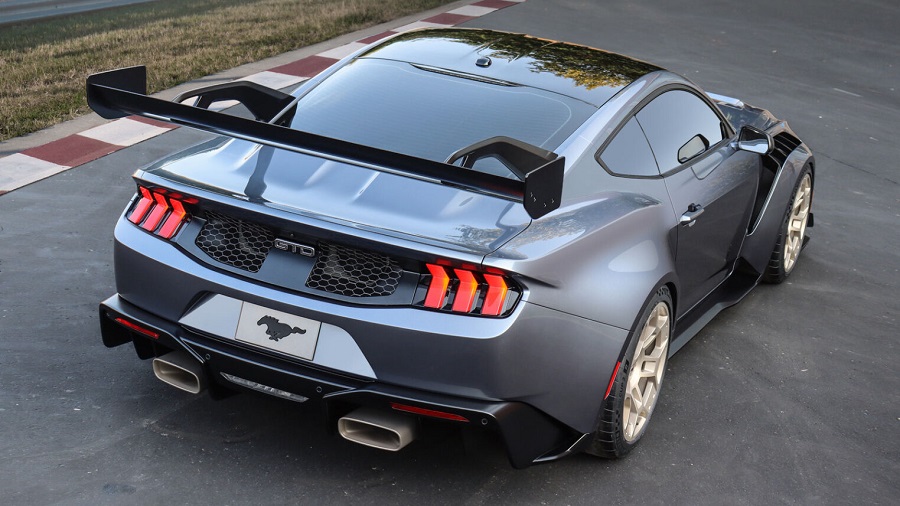The Ford Mustang GTD is the quickest, most advanced ‘Stang to roll off Ford’s production line. This ain’t no pony car, this is the real deal.
A little while ago, Ford announced that it was taking customer motorsport seriously, and promptly unveiled the Mustang GT3 racecar with which it’ll return to Le Mans next year. However, what they failed to mention at the time was that alongside that thoroughbred track-only racecar, a highly modified street-legal apex warrior was also in development. Yes, this is a Ford Mustang with true racecar DNA, and on paper, the credentials worthy of a place alongside Europe’s elite.
So, what has Ford done to turn its soft but brawny muscle car into a self-proclaimed Porsche rival? And do those claims even remotely stack up? Well, here’s what we know so far…

Ford Mustang GTD – What is it?
“Mustang GTD shatters every preconceived notion of a supercar,” says Jim Farley, Ford president and CEO. “This is a new approach for us. We didn’t engineer a road car for the track, we created a race car for the road. Mustang GTD takes racing technology from our Mustang GT3 race car, wraps it in a carbon fiber Mustang body and unleashes it for the street.”
“This is our company, we’re throwing down the gauntlet and saying, ‘Come and get it,’” he continues. “We’re comfortable putting everybody else on notice. I’ll take track time in a Mustang GTD against any other auto boss in their best road car.”
DAMN, now that’s the rare kind of fighting talk that we don’t see too often from the big wigs. But, as fun as it’d be to see Farley take on Oliver Blume, Benedetto Vigna, and Koji Sato in a one-off shoot-out, let’s step back for a moment and try to understand where all this bad-ass bravado has come from. What is it that makes this Mustang so special?
The first clue lies with the people who built it. The Ford Mustang GTD is the fruit of a collaboration between Ford and Multimatic, the company which is building the new GT3 racecar, but which also built the mid-2010s Le Mans class-winning Ford GT. These guys have got serious experience with building serious performance cars, so the idea that they’d turn their attention to a road vehicle is frankly mouth-watering.
The best part is that, this isn’t all PR fluff, either. There is genuine racecar technology in this roadgoing Mustang, so let’s have a look at that next in more detail.

Ford Mustang GTD Aerodynamics & Handling Features
Aero
We’ll begin with the bodywork. The fenders, hood, trunk lid cover, door sills, splitter, rear diffuser, and roof are all carbon fiber. You can also equip your GTD with an extra carbon aero pack, comprised of an aerodynamic undertray and hydraulic front flap to further manage air flow in balance with the active rear wing.
In place of the regular Mustang’s trunk, that area of the car now houses the GTD’s rear suspension, a hydraulic control system, and a transaxle cooling system. That cooling system makes use of a motorsport inspired trunk lid cover, featuring two air scoops designed to funnel air from the back glasswork through into the heat exchangers. Proper clever stuff!
Suspension
On top of that, the Ford Mustang GTD is fitted with semi-active suspension all-round, adjustable in terms of both spring rate and ride height. In order to make this GTD usable on the road as well as the track, there are two suspension settings you can choose from; one for street use, the other for track days. In the latter mode, you’ll notice the ride height drop by a fairly significant 40mm.
The suspension itself has been constructed in such a manner to enhance lateral stiffness, making the car feel more planted through high-velocity, high-G corners. Adding to that is the tubular subframe chassis – another trick from the motorsport industry.

Ford Mustang GTD Powertrain
It’s no good having a beautifully-handling car if its engine feels underpowered. Thankfully, nobody needs to tell Ford that, seeing as they’ve dropped a 5.2-liter supercharged V8 under the hood. That thing will crank out 800 ponies, and is positioned in a deep front location to ensure a perfect 50/50 weight distribution.
Sticking to its roots, the Ford Mustang GTD hasn’t gone down the AWD route, as many modern supercars do. Instead, an 8-speed dual-clutch automatic gearbox sends the power via a carbon fiber driveshaft to the rear wheels only. When you hit the 7500rpm redline, the car’s active-valve Titanium exhaust will ensure that you’ve got the right soundtrack to match the performance. Oh, and if you’re bothered about actually stopping this monster, you can rest easy in the knowledge that it’s packing Brembo carbon ceramics.
How much does the Ford Mustang GTD cost?
The Ford Mustang GTD will arrive in 2025, as part of a limited production run for the North American market only. If you want one, it’ll cost you dear. $300,000 (or £234,000) to be precise. And at that price tag, then yeah, we’d certainly hope it was capable of matching Europe’s finest.
All in all, it’s still very early days for the Ford Mustang GTD. The world is yet to see how it truly performs on anything other than paper. But at the very least, Jim, you’ve certainly got our attention…





